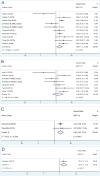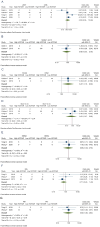Long-Noncoding-RNA HOTAIR Upregulation is Associated with Poor Breast Cancer Outcome: A Systematic Review and Meta Analysis
- PMID: 38679975
- PMCID: PMC11162707
- DOI: 10.31557/APJCP.2024.25.4.1169
Long-Noncoding-RNA HOTAIR Upregulation is Associated with Poor Breast Cancer Outcome: A Systematic Review and Meta Analysis
Abstract
Background: Breast cancer is the most frequent cancer among women worldwide with significant disproportionate mortality rates in developing countries. Although clinical management of breast cancer has been immensely improved, refinement in the prognostic and recurrent markers is still needed. Long non-coding RNAs (lncRNA) HOTAIR has recently been associated with poor outcome and is potentially used as a prognostic marker in breast cancer.
Methods: We comprehensively reviewed studies evaluating lncRNA HOTAIR in association with overall and disease-free survivals in breast cancers. Systematic searches were performed in Pubmed, ProQuest, ScienceDirect, Scopus, Google Scholar, Semantic Scholar, Springer, Nature, Sage Journals, and Wiley databases using combination keywords "long non-coding RNA," "lncRNA," "HOX transcript antisense RNA," "HOTAIR," "breast can-cer," "carcinoma mammae," "prognosis," and "survival." Risk of bias score was used to assess quality of studies, I2 test was conducted to assess heterogeneity. Meta-analysis was performed to compare HOTAIR expression with breast cancer survival rates using STATA v.17 software.
Results: Of the total 1,504 screened studies, seven studies were included in the meta-analysis involving 533 patients. High expression of HOTAIR was associated with poor survival rates (pooled HR: 1.69; 95%CI: 1.11-2.59; p=0.015), shorter overall survival (OS) (pooled HR: 1.33; 95%CI: 0.78-2.26; p=0.455), poor disease-free survival (DFS) (pooled HR: 2.40; 95%CI: 1.63-3.53; p<0.001), poor distant metastatic-free survival (MFS) (HR: 1.75; 95%CI: 1.13-2.71; p=0.012). In addition, overexpression of HOTAIR was associated with positive lymph node infiltration (pooled OR: 2.38; 95%CI: 0.53-10.69; p=0.26) and ductal type cancer (pooled OR: 3.27; 95%CI: 1.15-9.30; p=0.03).
Conclusion: Upregulation of lncRNA HOTAIR is associated with worse DFS aand MFS that can potentially be used as a prognostic marker in breast cancer patients.
Keywords: HOTAIR; Prognosis; breast cancer; long non-coding RNA; survival.
Conflict of interest statement
There is no conflict of interest in this research
Figures








Similar articles
-
The prognostic value of HOTAIR for predicting long-term prognosis of patients with gastrointestinal cancers.Medicine (Baltimore). 2018 Jun;97(26):e11139. doi: 10.1097/MD.0000000000011139. Medicine (Baltimore). 2018. PMID: 29952959 Free PMC article. Review.
-
Long noncoding RNA HOTAIR as an independent prognostic marker in cancer: a meta-analysis.PLoS One. 2014 Aug 26;9(8):e105538. doi: 10.1371/journal.pone.0105538. eCollection 2014. PLoS One. 2014. PMID: 25157956 Free PMC article.
-
[Prognostic value of lncRNA HOTAIR expression in patients with cancer: A Meta-analysis].Zhong Nan Da Xue Xue Bao Yi Xue Ban. 2016 Dec 28;41(12):1352-1357. doi: 10.11817/j.issn.1672-7347.2016.12.017. Zhong Nan Da Xue Xue Bao Yi Xue Ban. 2016. PMID: 28070051 Chinese.
-
Prognostic value of long non-coding RNA HOTAIR in various cancers.PLoS One. 2014 Oct 10;9(10):e110059. doi: 10.1371/journal.pone.0110059. eCollection 2014. PLoS One. 2014. PMID: 25303230 Free PMC article.
-
High expression level of long non-coding RNA HOTAIR is associated with poor overall survival in gastric cancer patients: evidence from meta-analysis.J BUON. 2017 Jul-Aug;22(4):911-918. J BUON. 2017. PMID: 29155520
Cited by
-
HOTAIR Promotes the Hyperactivation of PI3K/Akt and Wnt/β-Catenin Signaling Pathways via PTEN Hypermethylation in Cervical Cancer.Cells. 2024 Sep 4;13(17):1484. doi: 10.3390/cells13171484. Cells. 2024. PMID: 39273054 Free PMC article.
-
Functions and applications of RNA interference and small regulatory RNAs.Acta Biochim Biophys Sin (Shanghai). 2024 Nov 18;57(1):119-130. doi: 10.3724/abbs.2024196. Acta Biochim Biophys Sin (Shanghai). 2024. PMID: 39578714 Free PMC article. Review.
-
HMGA2 associated ceRNA-HOTAIR pathway in breast cancer patients from clinicopathological perspective.Turk J Med Sci. 2025 May 30;55(3):782-791. doi: 10.55730/1300-0144.6027. eCollection 2025. Turk J Med Sci. 2025. PMID: 40686703 Free PMC article.
References
-
- Sung H, Ferlay J, Siegel RL, Laversanne M, Soerjomataram I, Jemal A, et al. Global cancer statistics 2020: Globocan estimates of incidence and mortality worldwide for 36 cancers in 185 countries. CA Cancer J Clin. 2021;71(3):209–49. - PubMed
Publication types
MeSH terms
Substances
LinkOut - more resources
Full Text Sources
Medical

